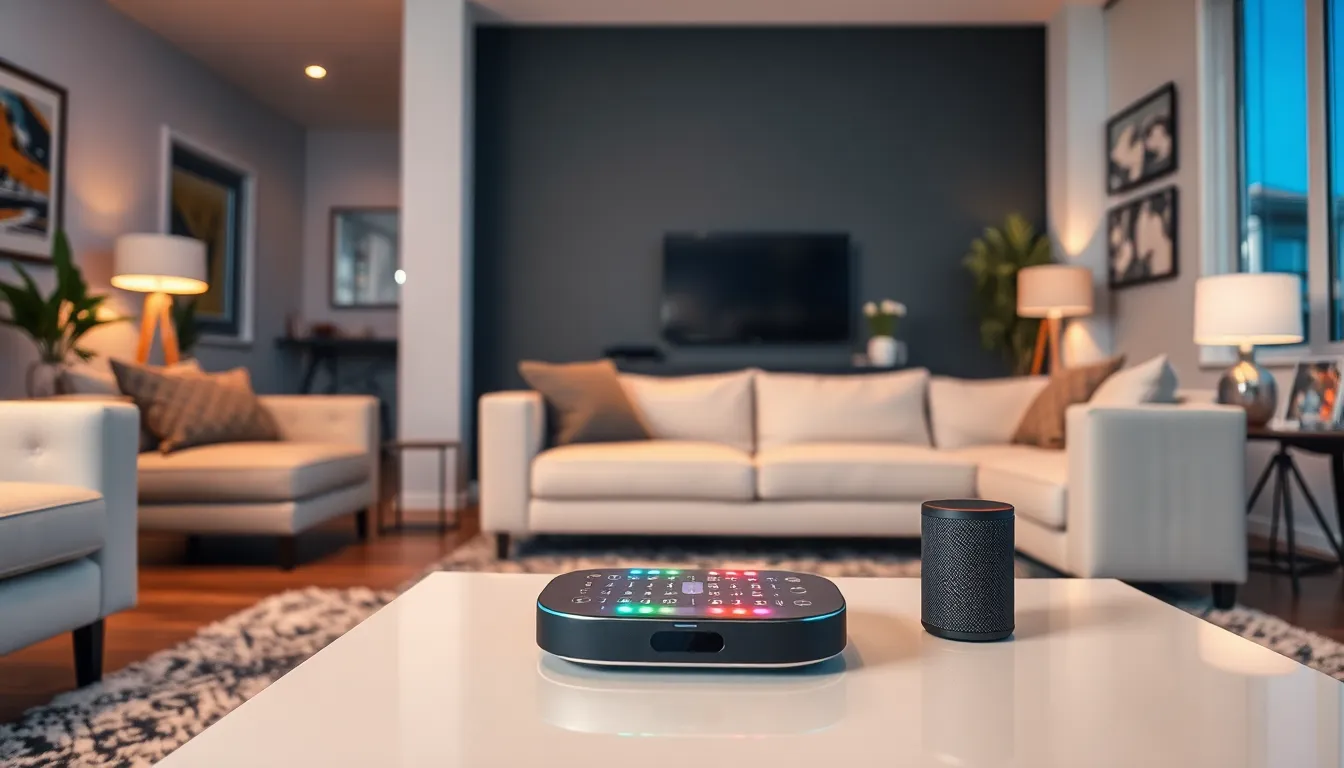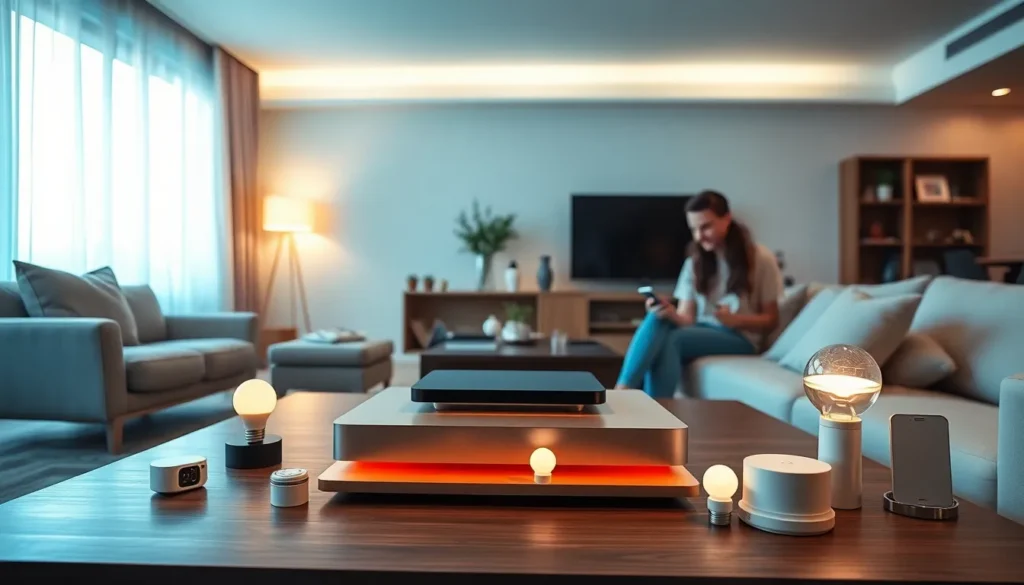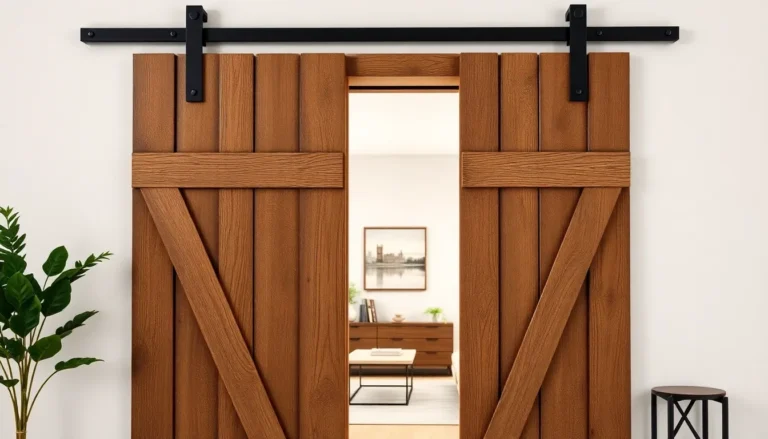Table of Contents
ToggleImagine walking into your home, and with a simple voice command, the lights dim, the thermostat adjusts, and your favorite playlist starts playing. Sounds like magic, right? Welcome to the world of smart home hubs, where technology meets convenience in a delightful dance. These nifty devices are the control center for all your smart gadgets, turning your house into a futuristic haven without the need for a wizard’s wand.
Overview of Smart Home Hubs
Smart home hubs function as vital central control systems for various smart devices, integrating them into a seamless network. Through these hubs, users can easily manage devices like smart lights, thermostats, and speakers from a single app or with voice commands. Functionality varies among different manufacturers, but most hubs support protocols like Zigbee, Z-Wave, and Wi-Fi, enhancing compatibility across multiple devices.
Smart home hubs improve user experience by automating tasks and creating routines. For instance, a user can program lights to turn on at sunset or the thermostat to adjust when they arrive home. These features not only boost convenience but also contribute to energy efficiency.
Interconnectivity plays an essential role in smart home ecosystems. Many hubs allow integration with third-party services, such as Amazon Alexa or Google Assistant, providing users with diverse control options. Additionally, smart home hubs often support IFTTT (If This Then That) for customized automation scenarios, giving users even more flexibility.
Security is another important aspect of smart home hubs. Several hubs include built-in security features, such as device monitoring and alerts for unusual activity. These capabilities help users maintain a safer home environment.
Considerations in choosing a smart home hub include device compatibility, setup ease, and the features important for user needs. Popular choices on the market, like Samsung SmartThings, Amazon Echo Plus, and Google Nest Hub, each offer unique advantages tailored to different users.
Key Features of Smart Home Hubs

Smart home hubs provide essential features that enhance automation and connectivity in the home.
Compatibility with Smart Devices
Compatibility with smart devices stands as a primary feature of smart home hubs. Each hub connects with a variety of devices, including lights, locks, cameras, and speakers. Many hubs support protocols like Zigbee and Z-Wave, expanding the range of compatible products. The ability to work with both popular brands and lesser-known devices increases versatility. Users can combine devices from different manufacturers, ensuring a customized experience tailored to their preferences. Selecting a hub that supports a wide array of devices guarantees future-proofing, allowing for easy integration of new technology.
User Interface and Control Options
User interface and control options significantly influence the usability of smart home hubs. Many systems provide intuitive mobile apps that enable easy navigation and management of connected devices. Voice control integration is common, allowing users to issue commands hands-free. Customizable dashboards in these apps can enhance organization, providing quick access to frequently used functions. Some systems offer compatibility with multiple voice assistants, giving users flexibility in their control preferences. Additionally, physical control options such as buttons or touchscreens add convenience for users who prefer tactile interaction.
Popular Smart Home Hubs on the Market
Smart home hubs streamline device management, supporting various smart products seamlessly. Here are some notable options.
Amazon Echo Plus
Amazon Echo Plus stands out with its built-in Zigbee hub, allowing connection to compatible devices directly. Users can control smart lights, locks, and sensors through simple voice commands, thanks to Alexa integration. An array of features, such as music streaming and smart home skills, enhances user experience. Echo Plus remains an excellent option for those who prioritize voice command functionality.
Google Nest Hub
Google Nest Hub excels with its intuitive touchscreen interface, providing easy access to smart home controls. Users appreciate voice interaction through Google Assistant, enabling natural dialogue. Displays provide visual feedback on routines, reminders, and media options. Nest Hub features compatibility with numerous devices, enhancing its versatility. Those seeking a streamlined user interface will find this device appealing.
Samsung SmartThings
Samsung SmartThings offers a robust platform for managing various smart devices. Support for Zigbee and Z-Wave protocols enables compatibility with numerous brands. Users appreciate the intuitive mobile app, allowing for easy device control and automation setup. SmartThings hubs facilitate the creation of customized routines, boosting energy efficiency and convenience. This option suits those looking for extensive compatibility and functionality.
Benefits of Using Smart Home Hubs
Smart home hubs offer multiple advantages that enhance daily living. Centralized control simplifies managing various smart devices through a single interface. Users gain convenience when adjusting lighting, temperature settings, or audio with voice commands, making interactions seamless.
Energy efficiency increases as well, thanks to automation features. Routines can be programmed effortlessly, allowing homeowners to schedule lights to illuminate at sunset or thermostats to adjust when they arrive. Cost savings frequently result from reduced energy usage.
Interconnectivity plays a crucial role, as most hubs work with third-party services like Amazon Alexa and Google Assistant. This compatibility allows users to create customized home automation sequences using solutions like IFTTT. Such flexibility ensures that devices from different brands can work together smoothly.
Security benefits also stand out with smart home hubs. Device monitoring provides insight into home activity, while alerts for unusual occurrences enhance safety. Users often appreciate the ability to track their smart cameras and locks from one centralized platform.
Choosing the right hub also brings unique features to the forefront. Options like smart light integration, security cameras, and smart locks can be combined for a personalized experience. Various hubs support protocols such as Zigbee and Z-Wave, enabling broader device compatibility.
User experience significantly impacts satisfaction. Many hubs include intuitive mobile apps and physical control options that simplify operation. This focus on usability further encourages more people to embrace smart technology in their homes.
Potential Drawbacks of Smart Home Hubs
Smart home hubs, despite their advantages, come with several potential drawbacks. Reliability issues may arise when device connections are weak or disrupted, leading to frustration when attempting to control gadgets. A single point of failure exists in smart home ecosystems; if the hub malfunctions, all connected devices may become unresponsive.
Security concerns also present a significant challenge. Cyber attacks on smart home devices can expose personal data, making robust security measures essential. Many consumers worry about privacy implications associated with these hubs, as they often store sensitive information.
Compatibility limitations may restrict the use of certain devices. Some hubs only support specific brands or protocols, limiting user choices and potentially leading to a fragmented smart home experience. Additionally, ongoing software updates are necessary to ensure that devices function correctly, which can be cumbersome and time-consuming.
Complexity might present another issue for users. Configuring multiple devices and setting automation routines can overwhelm individuals unfamiliar with smart technology. Finally, initial costs can be a barrier; purchasing a smart home hub and compatible devices can require a significant financial investment.
A comprehensive understanding of these potential drawbacks helps users make informed decisions when considering smart home hub adoption. Addressing reliability, security, compatibility, complexity, and cost ensures a more knowledgeable approach to enhancing home automation effectively.
Conclusion
Smart home hubs represent a significant advancement in home automation. They offer users the ability to streamline their daily routines while enhancing convenience and security. By integrating various devices into a cohesive network, these hubs simplify control and improve energy efficiency.
As technology continues to evolve, the potential for smart home hubs to transform living spaces grows. Users can enjoy a tailored experience that meets their specific needs. However, it’s crucial to weigh the benefits against potential drawbacks. Understanding these aspects will empower users to choose the right hub for their smart home ecosystem. Embracing this technology can lead to a more connected and efficient lifestyle.




